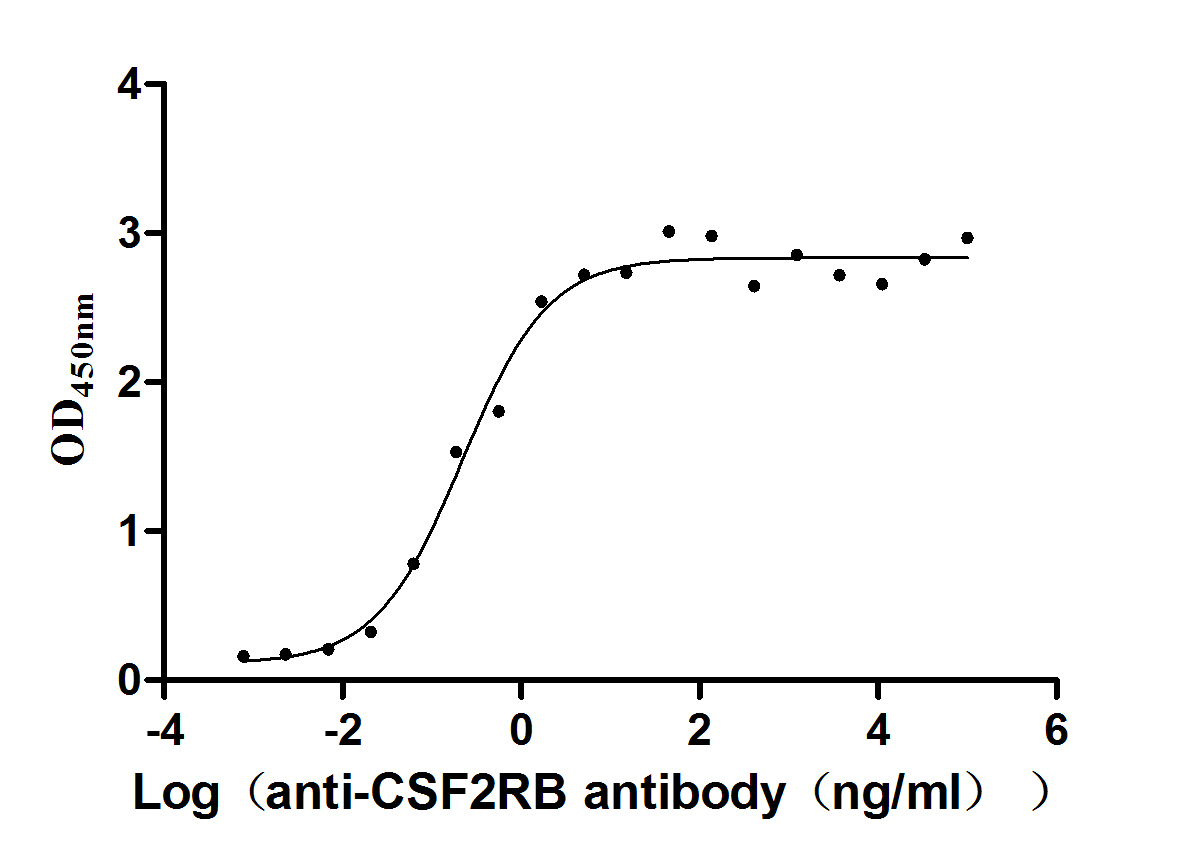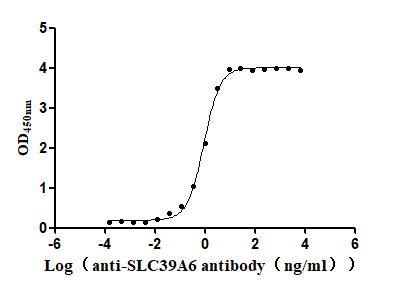Recombinant Human Mediator of DNA damage checkpoint protein 1 (MDC1), partial
-
货号:CSB-BP623929HU
-
规格:
-
来源:Baculovirus
-
其他:
-
货号:CSB-EP623929HU-B
-
规格:
-
来源:E.coli
-
共轭:Avi-tag Biotinylated
E. coli biotin ligase (BirA) is highly specific in covalently attaching biotin to the 15 amino acid AviTag peptide. This recombinant protein was biotinylated in vivo by AviTag-BirA technology, which method is BriA catalyzes amide linkage between the biotin and the specific lysine of the AviTag.
-
其他:
-
货号:CSB-MP623929HU
-
规格:
-
来源:Mammalian cell
-
其他:
产品详情
-
纯度:Greater than 85% as determined by SDS-PAGE.
-
基因名:Name:MDC1 Synonyms:KIAA0170, NFBD1
-
Uniprot No.:
-
别名:Homologue to Drosophila photoreceptor protein calphotin; MDC 1; Mdc1; MDC1_HUMAN; Mediation of DNA damage checkpoint 1; Mediator of DNA damage checkpoint 1; Mediator of DNA damage checkpoint protein 1; NFBD 1; NFBD1; Nuclear factor with BRCT domains 1; Nuclear Factor with BRCT Domains Protein 1
-
种属:Homo sapiens (Human)
-
蛋白长度:Partial
-
蛋白标签:Tag type will be determined during the manufacturing process.
The tag type will be determined during production process. If you have specified tag type, please tell us and we will develop the specified tag preferentially. -
产品提供形式:Lyophilized powder
Note: We will preferentially ship the format that we have in stock, however, if you have any special requirement for the format, please remark your requirement when placing the order, we will prepare according to your demand. -
复溶:We recommend that this vial be briefly centrifuged prior to opening to bring the contents to the bottom. Please reconstitute protein in deionized sterile water to a concentration of 0.1-1.0 mg/mL.We recommend to add 5-50% of glycerol (final concentration) and aliquot for long-term storage at -20℃/-80℃. Our default final concentration of glycerol is 50%. Customers could use it as reference.
-
储存条件:Store at -20°C/-80°C upon receipt, aliquoting is necessary for mutiple use. Avoid repeated freeze-thaw cycles.
-
保质期:The shelf life is related to many factors, storage state, buffer ingredients, storage temperature and the stability of the protein itself.
Generally, the shelf life of liquid form is 6 months at -20°C/-80°C. The shelf life of lyophilized form is 12 months at -20°C/-80°C. -
货期:Delivery time may differ from different purchasing way or location, please kindly consult your local distributors for specific delivery time.Note: All of our proteins are default shipped with normal blue ice packs, if you request to ship with dry ice, please communicate with us in advance and extra fees will be charged.
-
注意事项:Repeated freezing and thawing is not recommended. Store working aliquots at 4°C for up to one week.
-
Datasheet :Please contact us to get it.
相关产品
靶点详情
-
功能:Required for checkpoint mediated cell cycle arrest in response to DNA damage within both the S phase and G2/M phases of the cell cycle. May serve as a scaffold for the recruitment of DNA repair and signal transduction proteins to discrete foci of DNA damage marked by 'Ser-139' phosphorylation of histone H2AX. Also required for downstream events subsequent to the recruitment of these proteins. These include phosphorylation and activation of the ATM, CHEK1 and CHEK2 kinases, and stabilization of TP53 and apoptosis. ATM and CHEK2 may also be activated independently by a parallel pathway mediated by TP53BP1.
-
基因功能参考文献:
- Our data highlight that NFBD1 participates in the regulation of proliferation and apoptosis in laryngeal squamous cell carcinoma PMID: 28921460
- These findings indicate that the c-Fos/miR-22/MDC1 axis plays a relevant role in DNA repair in terminally differentiated cells, which may facilitate our understanding of molecular mechanism underlying the downregulating DNA repair in differentiated cells. PMID: 28637007
- key component of the DNA damage response and interacts with several factors such as gamma-H2AX PMID: 29026069
- prognostic marker in predicting relapse-free survival in oral squamous cell carcinoma PMID: 28161894
- It showed a link between the status of MDC1 protein and TP53 gene, which specific mutations caused radiation-induced MDC1 down-regulation. PMID: 28397142
- ASF1a promotes non-homologous end joining repair by facilitating phosphorylation of MDC1 by ATM at double-strand breaks. PMID: 28943310
- the opposing activities of RNF4 and ataxin-3 consolidate robust MDC1-dependent signaling and repair ofDNA double-strand break. PMID: 28275011
- NFBD1 protein is overexpressed in NPC tissues and that silencing NFBD1 can inhibit cell growth, induce apoptosis, increase the production of intracellular ROS. NFBD1 knockdown also inhibits the tumorigenicity of NPC cells in vivo. PMID: 28081741
- NFBD1 knockdown improves the chemosensitivity of NPC cells by inhibiting cell growth and promoting apoptosis through the impairment of DNA damage repair, suggesting NFBD1 as a novel therapeutic target for NPC. PMID: 27334757
- knockdown of MCM2 or MCM6 could significantly inhibit foci forming of MDC1 in TE-1 nuclei in response to bleomycin-induced DNA damage (p < 0.001). This study indicates the direct interaction between MDC1 and MCMs in TE-1 nuclei. PMID: 27908247
- MDC1 recruits TNKS1 and TNKS2 to DNA lesions. PMID: 26845027
- MDC1 silencing enhances the radiosensitivity of human nasopharyngeal cancer CNE1 cells and results in xenograft tumor growth inhibition. PMID: 26247734
- we generated two HEP-2 cell lines with a stable knockdown of MDC1 or 53BP1 with short hairpin RNA (shRNA), respectively, and investigated the effect of MDC1 and 53BP1 on cell radiosensitivity PMID: 25976740
- During replicative senescence and stress-induced premature senescence, MDC1 is downregulated by upregulating miR-22. PMID: 25627978
- we have identified a novel antisense lncRNA MDC1-AS, which may participate in bladder cancer through up-regulation of its antisense tumor-suppressing gene MDC1 PMID: 25514464
- our findings suggest that MDC1 promotes ovarian cancer metastasis through the induction of EMT. PMID: 25592380
- The study suggest that MDC1 as an epigenetic modifier regulates androgen receptor transcriptional activity and MDC1 may function as a tumor suppressor of prostate cancer. PMID: 25934801
- data suggested that the SNP rs4713354A>C of MDC1 may be a functional genetic biomarker for susceptibility to lung cancer in Chinese PMID: 25198518
- NFBD1/MDC1 is phosphorylated by PLK1 and controls G2/M transition through the regulation of a TOPOIIalpha-mediated decatenation checkpoint. PMID: 24349352
- ATM and MDC1 maintain genomic stability not only by controlling the DNA damage response, but also by regulating spindle assembly checkpoint activation, providing an important link between these two essential biological processes. PMID: 24509855
- The TOPBP1 phosphate-binding pocket and positively charged residues in a variant loop in BRCT5 present an extended binding surface for the negatively charged MDC1 phosphopeptide. PMID: 23891287
- Silencing MDC1 can enhance the radiosensitivity of esophageal squamous cell carcinoma ECA109 cells in vitro. PMID: 20813677
- PARP1 activation and BAL1-BBAP recruitment to DNA damage sites are independent of ATM and MDC1. PMID: 23230272
- proteins accumulate into foci with characteristic mean recruitment times tau(1). Mdc1 accumulates faster than 53BP1 after high LET irradiation PMID: 22860035
- inhibition in the activity of the core mitotic regulator CDK1 enhances MDC1-gammaH2AX colocalization in mitosis. PMID: 22962268
- A dual interaction between the DNA damage response protein MDC1 and the RAG1 subunit of the V(D)J recombinase. PMID: 22942284
- distinct dynamics of MDC1 and 53BP1 at different types of nuclear structures PMID: 22677490
- It was shown that MDC1 is sumoylated after DNA damage, and sumoylation of MDC1 at Lys1840 is needed for MDC1 degradation and removal of MDC1 and 53BP1 from DNA damage sites. Sumoylated MDC1 was ubiquitinated by the SUMO-targeted E3 ubiquitin ligase RNF4. PMID: 22635276
- A major binding target of the Mdc1 FHA domain is a previously unidentified DNA damage and ATM-dependent phosphorylation site near the N-terminus of Mdc1 itself. PMID: 22234878
- expression of NFBD1 seems to be related to the oncogenic potential of cervical cancer, and suppression of its expression can inhibit cancer cell growth both in vitro and in vivo PMID: 21853275
- As compared to the MDC1 forkhead-associated FHA) domain, the MU2 FHA domain dimerizes using a different and more stable interface and contains a degenerate phosphothreonine-binding pocket. PMID: 22273583
- MDC1 is required for the recruitment of RAP80 to DNA double-strand breaks. PMID: 21857162
- structural insight into MDC1-CHK2 interaction PMID: 22211259
- This study provides the first evidence that interactions involving MDC1 can be regulated by ubiquitylation PMID: 21622030
- most NFBD1 regulated genes are regulated in both the absence and presence of IR, thus pointing toward a novel function for NFBD1 outside of the DNA damage response PMID: 21551225
- this study reveals that human NIPBL is a novel protein recruited to DSB sites, and the recruitment is controlled by MDC1, RNF168 and HP1gamma. PMID: 21784059
- The specific TopBP1-MDC1 interaction was mediated by the fifth BRCT domain of TopBP1 and the Ser-Asp-Thr repeats of MDC1. TopBP1 accumulation at stalled replication forks was promoted by the H2AX/MDC1 signaling cascade. PMID: 21482717
- Mediator of DNA damage checkpoint protein 1 (MDC1) has a role in nodal recurrence in early-stage breast cancer patients treated with breast-conserving surgery and radiation therapy PMID: 20521098
- Results implicate MDC1 in the cellular apoptotic response. PMID: 21148072
- High NFBD1 is associated with esophageal cancer. PMID: 20364298
- The viral oncoprotein tax sequesters DNA damage response factors by tethering MDC1 to chromatin. PMID: 20729195
- NFBD1 has a pivotal role in the regulation of proper mitotic entry. PMID: 20529673
- MDC1 and 53BP1 expressions were observed for the first time in human esophageal carcinoma cell lines TE-1,TE-13 and Eca109 cells, at both the mRNA and protein levels. PMID: 17884766
- structure & peptide binding specificity of BRCT domains of MDC1 & BRCA1; crystal structures of BRCA1 & MDC1 bound to peptides show differences in the environment of conserved arginines that determine affinity for peptides with -COO(-) vs -CO-NH(2) termini PMID: 20159462
- This nuclear protein with signature motifs of FHA and BRCT, and an internal 41-amino acid repeat sequence, is an early participant in DNA damage response. PMID: 12475977
- role in DNA damage signaling pathways PMID: 12499369
- NFBD1 is parallel to 53BP1 in regulating Chk2 and downstream of H2AX in the recruitment of repair and signaling proteins to sites of DNA damage in tumor cells PMID: 12551934
- MDC1-mediated focus formation by the MRE11 complex at sites of DNA damage is crucial for the efficient activation of the intra-S-phase checkpoint PMID: 12607003
- MDC1 is recruited through its FHA domain to the activated CHK2 and has a critical role in CHK2-mediated DNA damage responses PMID: 12607004
- role for MDC1 in mediating transduction of the DNA damage signal PMID: 12607005
显示更多
收起更多
-
亚细胞定位:Nucleus. Chromosome. Note=Associated with chromatin. Relocalizes to discrete nuclear foci following DNA damage, this requires 'Ser-139' phosphorylation of H2AX. Colocalizes with APTX at sites of DNA double-strand breaks.
-
组织特异性:Highly expressed in testis.
-
数据库链接:
HGNC: 21163
OMIM: 607593
KEGG: hsa:9656
STRING: 9606.ENSP00000365588
UniGene: Hs.653495
Most popular with customers
-
Express system: Mammalian cell
Species: Homo sapiens (Human)
-
Recombinant Human Cytokine receptor common subunit beta (CSF2RB), partial (Active)
Express system: Mammalian cell
Species: Homo sapiens (Human)
-
Recombinant Human Microtubule-associated protein tau (MAPT) (Active)
Express system: Mammalian cell
Species: Homo sapiens (Human)
-
Recombinant Macaca fascicularis lymphocyte antigen 6 family member G6D (LY6G6D) (Active)
Express system: Yeast
Species: Macaca fascicularis (Crab-eating macaque) (Cynomolgus monkey)
-
Recombinant Human C-C chemokine receptor type 8 (CCR8)-VLPs (Active)
Express system: Mammalian cell
Species: Homo sapiens (Human)
-
Recombinant Human Cell adhesion molecule 1 (CADM1), partial (Active)
Express system: Mammalian cell
Species: Homo sapiens (Human)
-
Recombinant Human Gastric inhibitory polypeptide receptor(GIPR),partial (Active)
Express system: Mammalian cell
Species: Homo sapiens (Human)
-
Recombinant Macaca fascicularis Zinc transporter ZIP6 isoform X1(SLC39A6),partial (Active)
Express system: Baculovirus
Species: Macaca fascicularis (Crab-eating macaque) (Cynomolgus monkey)




-AC1.jpg)















